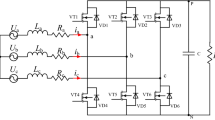Abstract
Reducing power losses in rectifiers remains a major challenge not only for industrial AC powered devices but also for high performance, high power density systems, low voltage automotive electronics, avionics, telephony applications, green energy, and battery-powered mobile applications. One approach to solve this problem is to use active MOSFET-based rectifiers. The methodological issues of reducing losses in the rectifier device, the features of active rectifiers’ circuitry, and the existing element base presented on the market of electronic components are considered.






Similar content being viewed by others
REFERENCES
Wang, S. and Yeh, W., Improving efficiency with an active switch on an AC bridge, RadioLotsman, 2021, no. 114, pp. 47–49. https://www.rlocman.ru/review/article.html?di=641915.
Why you should consider ideal diodes in your designs, ELE Times Research Desk, February 11, 2019. www.eletimes.com/why-you-should-consider-ideal-diodes-in-your-designs.
Babenko, V.P., Bityukov, V.K., and Simachkov, D.S., AC power MOSFET switch, in Sbornik nauchnykh statei po materialam V Mezhdunarodnoi nauchno-prakticheskoi konferentsii “Aktual’nye problemy i perspektivy razvitiya radiotekhnicheskikh i infokommunikatsionnykh sistem” Radioinfokom-2021 (Proceedings of the 5th International Conference on Actual Problems and Prospects for the Development of Radio Engineering and Infocommunication Systems), Moscow: RTU MIREA, 2021, pp. 305–308.
Babenko, V.P. and Bityukov, V.K., Simulation of switching of high-power FETS using the electronics Workbench Software, J. Commun. Technol. Electron., 2019, vol. 64, no. 2, pp. 176–181. https://sciencejournals.ru/view-article/?j=radel&y=2019&v=64&n=2&a= RadEl1902002Babenko.
Babenko, V.P., Bityukov, V.K., Kuznetsov, V.V., and Simachkov, D.S., Simulation of static and dynamic losses in MOSFET keys, Ross. Tekhnol. Zh., 2018, vol. 6, no. 1, pp. 20–39. https://www.rtj-mirea.ru/ jour/article/view/98.
Bityukov, V.K., Simachkov, D.S., and Babenko, V.P., Istochniki vtorichnogo elektropitaniya (Secondary Power Sources), 4th ed., Vologda: Infra-Inzheneriya, 2020.
Babenko, V.P. and Bityukov, V.K., Energy and noise characteristics of a SEPIC/CUCK converter with bipolar output, Russ. Microelectron., 2021, vol. 50, no. 5, p. 357.
Babenko, V.P., Bityukov, V.K., and Simachkov, D.S., DC/DC buck-boost converter with single inductance, Russ. Microelectron., 2021, vol. 50, no. 6, p. 471.
Basics of ideal diodes, Application Note, no. SLVAE57B, Texas Instruments, 2021. www.ti.com/lit/an/slvae57b/ slvae57b.pdf?ts=1639001451460.
Patoka, M., Fundamentals of power system ORing, Texas Instruments, 2007. www.edn.com/FUNDAMENTALS-OF-POWER-SYSTEM-ORING/.
Graña, C.Q. and Acevedo, J.M., MOSFET provides high power at low loss, RadioLotsman, 2011, June, pp. 42–43. www.rlocman.ru/shem/schematics.html? di=105520.
Tomasz, M., Use a self-powered op amp to create a low-leakage rectifier, RadioLotsman, 2011, October. www.rlocman.ru/shem/schematics.html?di=112905.
Chytil, J., Practical realization of ideal diode full-wave rectifiers, Inform. Autom. Pomiary Gospod. Ochr. Środowiska, 2014, no. 4 (4), pp. 81–84. www.researchgate.net/ publication/287865323_PRACTICAL_REALIZATION_ OF_IDEAL_DIODE_FULL-WAVE_RECTIFIERS.
Brad, P., Rectifier Bridge with no. 2VF drop, Theta Eng. www.thetaeng.com/designIdeas/FETBridge.html.
Crutschow, A simple and inexpensive ideal-diode MOSFET circuit, Power Electron. Tips. www.powerelectronictips.com/inexpensive-ideal-diode-mosfet-circuit/. Accessed September 26, 2017.
Created the ideal diode, LiveJournal. https://stone-guest.livejournal.com/46078.html. Accessed September 20, 2017.
LM74610-Q1 0.48-V to 42-V, zero IQ automotive ideal diode controller. www.ti.com/product/LM74610-Q1.
Buch, St., Active diodes for bridge rectifiers cut that pesky 0.6V drop, Electronics Weekly, 2021. www.electronicsweekly.com/news/products/analog/active-diodes-bridge-rectifiers-cut-pesky-0-6v-drop-2021-03/. Accessed March 24, 2021.
Datasheet Ideal Diode Bridge Controller LT4320/ LT4320-1. www.farnell.com/datasheets/1780637.pdf.
PD70224 Datasheet IdealBridgeTM Dual MOSFET-based Bridge Rectifier. www.microsemi.com/document-portal/doc_download/131677-pd70224-datasheet. Accessed August 2019.
Giacomini, D. and Cine, L., A highly efficient approach to building input diode bridges, RadioLotsman, 2009, no. 10, pp. 22–25. https://www.rlocman.ru/ shem/schematics.html?di=61045.
Babenko, V.P. and Bityukov, V.K., Topology of non-inductive DC/DC converters with galvanic circuit separation, Ross. Technol. Zh., 2021, vol. 9, no. 2, pp. 66–77.
Babenko, V.P. and Bityukov, V.K., Energy and noise characteristics of the SEPIC buck-boost converter with unipolar and bipolar output, Ross. Technol. Zh., 2021, vol. 9, no. 4, pp. 9–19.
Author information
Authors and Affiliations
Corresponding author
Ethics declarations
The authors declare that they have no conflicts of interest.
Rights and permissions
About this article
Cite this article
Babenko, V.P., Bityukov, V.K. Active Rectifier with Low Losses. Russ Microelectron 51, 318–324 (2022). https://doi.org/10.1134/S1063739722050031
Received:
Revised:
Accepted:
Published:
Issue Date:
DOI: https://doi.org/10.1134/S1063739722050031




